Chinese Dynasty: Han Dynasty Part III - the Eastern Han (25 – 220 CE)
The Eastern Han Dynasty (东汉, Dōng Hàn, 25-220 CE) was a period of Chinese history that followed the Western Han Dynasty (202 BCE to 8 CE) and Xin Dynasty (9 to 23 CE) and preceded the Three Kingdoms Period (220 to 280 CE). It was a time of relative peace and prosperity in China, marked by the development of literature, art, science, and technology, as well as the expansion of the empire's territory.
Establishment
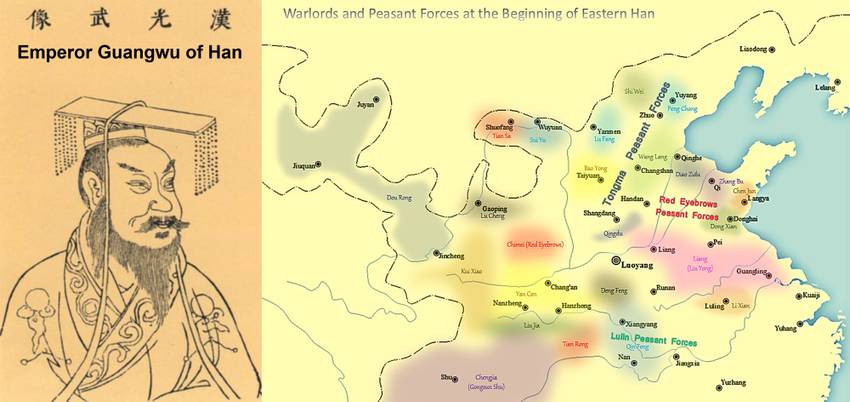
Left: a portrait of Emperor Guangwu. Right: map of early Eastern Han.
In 9 CE, Wang Mang (王莽) usurped the throne from Han and established the Xin Dynasty. During his reign, he implemented a series of reforms aiming to solve civil conflicts that intensified at the end of the Western Han Dynasty. However, his reforms hurt the vested interests of the powerful and many upper-level bureaucrats, coupled with idealization and poor implementation of reforms, he was strongly opposed and rejected. Not only did he fail to solve social conflicts, but new problems also arose. In addition, floods and droughts occurred and widespread peasant uprisings broke out. The empire fell into chaos and Wang Mang was killed in 23 CE, which concluded the Xin Dynasty.
Following the collapse of Xin, a power struggle erupted among regimes in different regions and the entire country was still in a state of chaos. Liu Xiu (刘秀), who was a descendant of the Western Han imperial family, emerged as a prominent leader. He established the Eastern Han Dynasty in 25 CE, with Luoyang (洛阳) as its capital.
After ascending the throne, Liu Xiu, also known as the Emperor Guangwu of Han (汉光武帝), eliminated all the separatist forces including Chimei (or Red Eyebrows, 赤眉), and the whole country was finally unified in 37 CE.
Early Reign
After establishing the Eastern Han Dynasty, Liu Xiu began to rebuild the country and consolidate his power. He abolished Wang Mang's reforms, rectified the administration of officials, set up six ministers to share state affairs, weaken the power of the Three Councilors of State (三公 sān gōng), and strengthen the centralization of power.
At the same time, he surveyed the land, established a new tax system, and revitalized agriculture, gradually stabilizing people's lives. He also released slaves or raised their legal status, so that a lot of them were freed as common people. Along with refugees, a large number of people returned to the countryside to promote production.
Overall, during Emperor Guangwu's reign, the life and production destroyed by the war were quickly restored, and the population and the number of cultivated fields greatly increased. Therefore, this period was called Guangwu Zhongxing (or Guangwu Restoration, 光武中兴, 25-57 CE) in history.
Periods of Stability and Prosperity
The rule of Ming Zhang
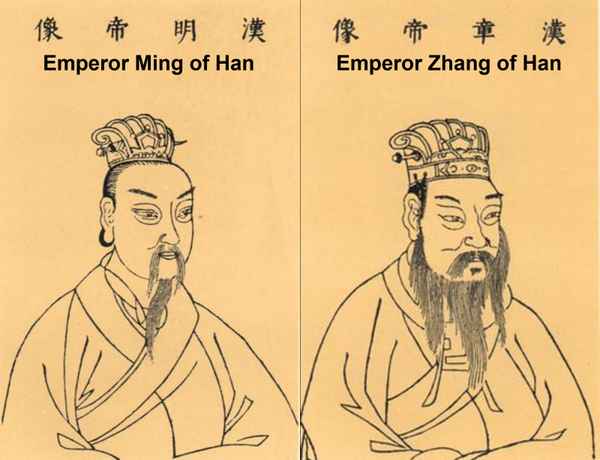
Portraits of Emperors Ming and Zhang of Han
After Emperor Guangwu, Emperor Ming (汉明帝) and Emperor Zhang of Han (汉章帝) successively succeeded, pushing the Eastern Han Dynasty to its peak. It was one of the golden ages in the history of the Han Dynasty, known in history as the Rule of Ming Zhang (明章之治, 57-88 CE).
Politics
Emperors Ming and Zhang succeeded and carried forward the lenient governance and enlightened policies of Emperor Guangwu, governing by both punishment and virtue, enacting clear laws and regulations, rectifying the conduct of officials, and strictly guarding against powerful families and nobles. They also adhered to the policy of not allowing imperial consorts and their families to participate in politics, a way to enhance the centralization and stability of power.
Economic Policies
In terms of social and economic policies, Emperors Ming and Zhang lightened the burden of taxes, encouraged agriculture and sericulture, promoted the development of water conservancy, provided multiple relief efforts for widows, orphans, and the poor, and completed the renovation of the Bian River Canal (汴渠), which had been damaged since the Western Han Dynasty.
In addition, since the end of the Western Han, the Yellow River had been in disrepair, and it diverted during Wang Mang's Xin Dynasty, causing major floods. Emperor Ming of Han sent water conservancy expert Wang Jing (王景) to control the Yellow River in 69 CE, which was the largest water conservancy project during his reign. Since then, the Yellow River has not undergone major diversions over the next 900 years.
Culture
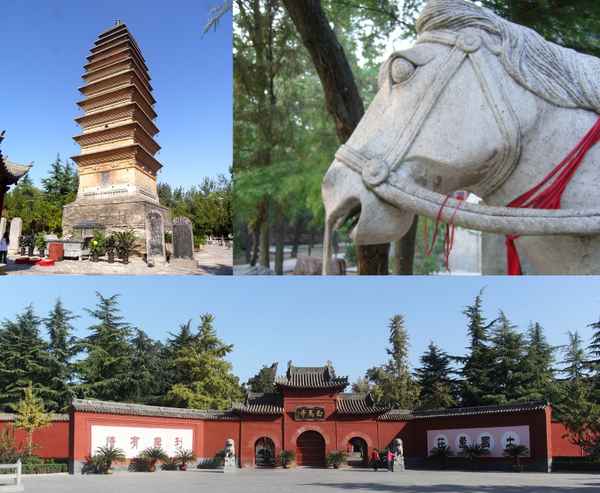
White Horse Temple
Furthermore, the two emperors promoted education and used Confucianism to govern the country. They also introduced Buddhism from the Western Regions (西域), resulting in a society with a refined and peaceful culture.
The first Buddhist temple, the White Horse Temple (白马寺), was established in Luoyang.
Emperors Ming and Zhang's reigns made people safe and their businesses stable, resulting in population growth. In the late years of Emperor Guangwu (~57 CE), the registered population was more than 21 million. By the end of the reign of Emperor Ming (~75 CE), the population had already surged to more than 34 million in less than 20 years.
Prosperity of Yongyuan
During the reign of Emperor He of Han (汉和帝) from 89 to 105 CE, the Eastern Han's strength reached its peak. The society enjoyed peace and harmony, as well as the prosperity of the people, which became known as the Yonyuan Period (or Prosperity of Yongyuan, 永元之隆. Yongyuan is the year title).
External Relations
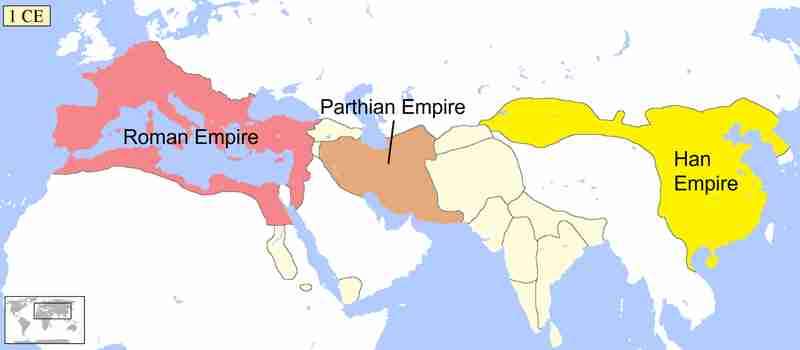
Map of Eurasia in the First Century
During this period, Dou Xian (窦宪) gained huge success against the Xiongnu (匈奴), while Ban Chao (班超) defeated the Kushan Empire (贵霜帝国) and pacified the Western Regions, resulting in more than fifty Western Region kingdoms submitting to Eastern Han.
Gan Ying (甘英) was sent to the Roman Empire in 97 CE and returned from the eastern coast of the Mediterranean, marking the first direct contact between Europe and China. Although he did not succeed in reaching the Roman Empire and establishing direct diplomatic relations, his journey reached the countries around the Persian Gulf.
Culture
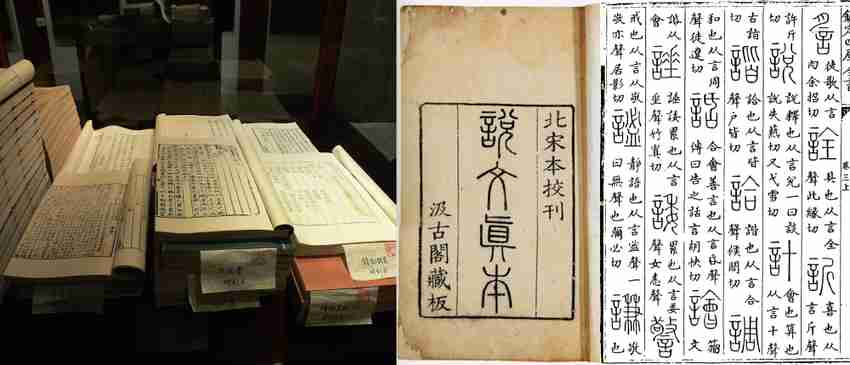
Left: Book of Han carved in the Ming Dynasty. Right: reprints of a Song Dynasty "veritable" edition of Shuowen Jieji.
Ban Zhao (班昭), the first known female Chinese historian, completed her brother Ban Gu's (班固) work on the history of the Western Han, the Book of Han (or History of the Former Han, 《汉书》 or 《前汉书》).
Xu Shen (许慎) compiled one of the world's earliest dictionaries, Shuowen Jiezi (《说文解字》), with character structure analyses and the principle of organization by sections with radicals (部首), establishing a theoretical system for Chinese characters.
Technology
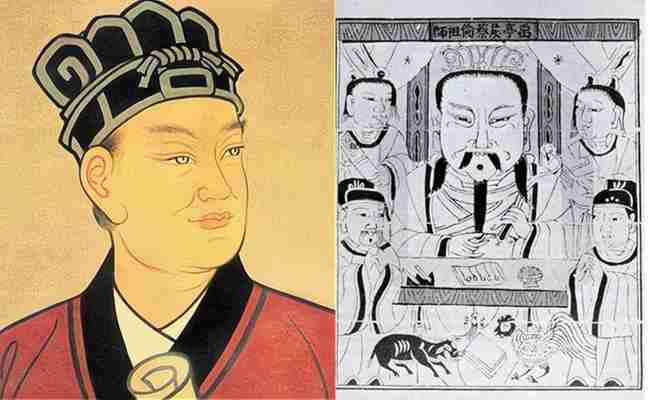
Left: a portrait of Cai Lun. Right: Qing Dynasty print of Cai Lun as the patron of papermaking.
Cai Lun (蔡伦) improved military weapons, and his swords and various other weapons remained at the technological pinnacle for a long time. More importantly, he innovated the paper-making process, leading to the production of Caihou paper (蔡侯纸).
Cai transformed the manufacturing technique of paper based on the work of previous scholars, which freed Chinese writing from the use of bamboo slips and contributed to the development of papermaking (造纸术), which is now one of the well-known Four Great Inventions (四大发明) of ancient China.
According to the Book of the Later Han (《后汉书》), from the reign of Emperor Guangwu to the Yongyuan period, peace and stability remained despite occasional fluctuations, and the population continued to grow steadily (reached 53 million at the end of Emperor He's reign in 105 CE).
The territory expanded with generations, with troops pacifying the north, and the Western Regions becoming more accessible. The moral standard of society at that time far exceeded that of the ancient Three Dynasties (Xia, Shang, and Zhou), and science and technology made great advances relative to previous eras.
The Fall of Eastern Han
Control of Powerful Families and Eunuchs
Emperor He passed away at only the age of 27 in 106 CE. After his death, powerful families led by Empress Dowagers or their relatives took control of the court, making the succeeding emperors, often very young children or even infants, their puppets.
In 159 CE, Emperor Huan of Han (汉桓帝), in conjunction with the eunuchs, overthrew the powerful Liang family (梁氏戚族). He granted titles to the eunuchs who had helped, making them the dominant force in the court.
However, corruption among the eunuchs was even worse than among the powerful families, and many scholars and officials were dissatisfied. They allied themselves with the powerful families to resist the eunuchs, resulting in two Disasters of the Partisan Prohibitions (党锢之祸), which expelled honest scholars from the court.
By this point, the Eastern Han Dynasty had been in decline and was on the verge of collapse.
Yellow Turban Rebellion
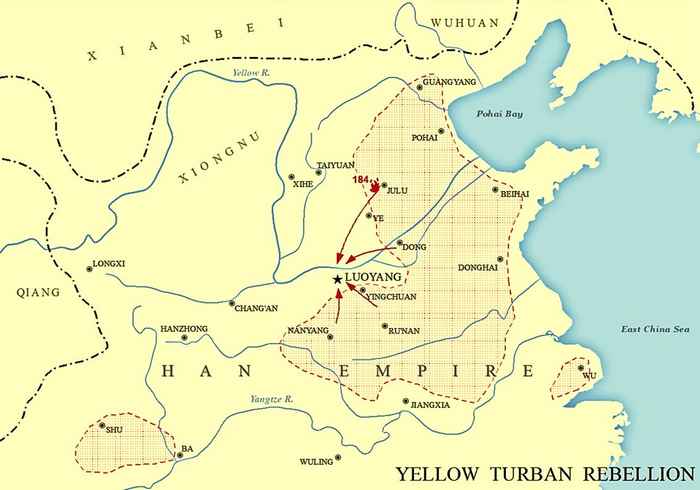
Map of Yellow Turban Rebellion
Emperor Ling of Han (汉灵帝), who took the throne in 168 CE, trusted the eunuchs even more and gave them more power over the central government. This worsened the situation even further.
In 184 CE, the Yellow Turban Rebellion (黄巾起义 or 黄巾之乱) broke out. To suppress the rebellion, Emperor Ling granted the power to local governments to raise their own armies to quell the unrest. This led to the formation of local military cliques, and the centralized power of the Han Dynasty began to crumble.
Although the Yellow Turban Rebellion ended the partisan prohibitions, the government did not improve.
Chaos at the End of Eastern Han
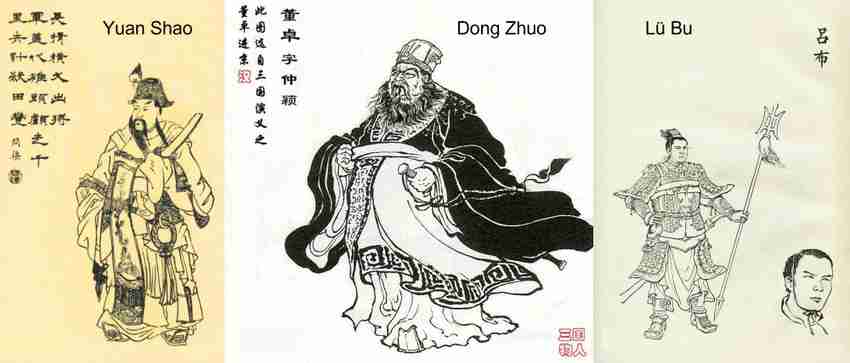
Portraits of Yuan Shao, Dong Zhuo, and Lü Bu
In 189 CE, Emperor Ling died and was succeeded by Emperor Shao of Han (汉少帝). The powerful eunuch faction in the court was a source of discontent for many, including the influential statesman Yuan Shao (袁绍). He suggested that the military commander Dong Zhuo (董卓), who held significant power in the northwest, be brought to the capital to help rid the court of the eunuchs.
Because their original plan to have the eunuchs executed was leaked in advance, Yuan Shao had to lead his troops into the palace and began to slaughter the eunuchs. Meanwhile, Dong Zhuo's army had arrived in the capital, Luoyang, and with the eunuchs and Empress Dowager He's (何太后) faction wiped out, he seized control of the court.
Dong Zhuo then replaced Emperor Shao with his younger brother, Liu Xie (刘协), who became Emperor Xian of Han (汉献帝). In 190 CE, Dong Zhuo had Emperor Shao and Empress Dowager He killed and moved Emperor Xian and his court to Chang'an (长安, present-day Xi'an, 西安).
Dong's actions caused dissatisfaction among local officials who formed a coalition led by Yuan Shao to resist him. However, the coalition ultimately failed due to infighting. Meanwhile, local officials across the country refused to obey the central government controlled by Dong Zhuo and became warlords expanding their own power, leading to the loss of prestige of the court.
In 192 CE, a court official named Wang Yun (王允) incited Dong Zhuo's general, Lü Bu (吕布), to assassinate Dong Zhuo. They succeeded and then issued a general amnesty. The authority of the court was temporarily restored. However, Dong Zhuo's generals, Li Jue (李傕) and Guo Si (郭汜), returned and killed Wang Yun, causing Lü Bu to flee. The Eastern Han court fell into chaos once again.
In 195 CE, Li Jue and Guo Si fought amongst themselves, prompting Emperor Xian and his officials to escape from Chang'an and return to Luoyang. However, Luoyang was in ruins, and Emperor Xian was left in a precarious situation.
From Eastern Han to the Three Kingdoms
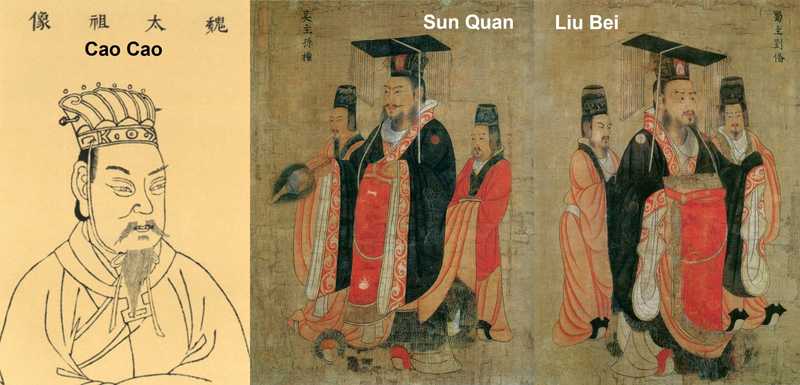
Portraits of Cao Cao, Sun Quan and Liu Bei
In 196 CE, Cao Cao (曹操) took Emperor Xian to Xudu (许都, present-day Xuchang, 许昌) as a captive. Afterward, Cao gradually gained control of the imperial court, leaving Emperor Xian under his control.
Starting from 200 CE, Cao Cao won decisive battles against Yuan Shao at Guandu (官渡) and Cangting (仓亭) and took control of the central plains and regions north of the Yellow River. He then took advantage of his victory over the Yuan clan to conquer Jingzhou (荆州).
In 208 CE, Cao Cao suffered a defeat in the Battle of Chibi (or Battle of Red Cliffs, 赤壁之战) against the allied forces of Sun Quan (孙权) and Liu Bei (刘备), which deprived him of the opportunity to conquer the southern regions and allowed Sun Quan and Liu Bei to develop their power and form the later Tripartite Confrontation of the Three Kingdoms.
In 212 and 216 CE, Cao Cao successively rose in ranks to Duke (魏公) and King of Wei (魏王), and established his heir, Cao Pi (曹丕), as the crown prince.
In 220 CE, Cao Cao passed away, and Cao Pi succeeded him as Prime Minister (丞相) as well as King of Wei. In October of the same year, Cao Pi forced Emperor Xian to abdicate and declared himself the emperor of a new dynasty called Wei (魏), known as Cao Wei (曹魏), marking the end of the Eastern Han Dynasty and the beginning of the Three Kingdoms period in Chinese history.
Cultural Achievements
The Eastern Han was one of the most significant periods in Chinese history with remarkable achievements in various areas.
Some of these achievements we have already mentioned above, but here is a list of significant cultural Eastern Han Dynasty achievements.
Technology
Papermaking
Cai Lun (蔡伦) invented the technology of using materials such as tree bark, hemp, scraps of cloth, and old fishing nets to make paper.
Since then, paper quickly replaced bamboo slips, wooden tablets, and silk cloth, facilitating the spread and promotion of literacy. Cai Lun's papermaking technique (造纸术) has become one of the famous Four Great Inventions (四大发明) of ancient China and is still in use today.
Pottery
The pottery industry also developed significantly. Some supplies that were previously exclusive to the wealthy and nobles began to enter the homes of ordinary people.
Porcelain at the time was fired at a higher temperature, and its water absorption was weaker. Judging from the unearthed artifacts, it is very close to the later Celadon.
Glazed pottery was also found in both the Yellow River Basin and the Yangtze River Basin.
Iron Technology
In the early Eastern Han, ironworkers invented the hydraulic blast furnace (水力鼓风炉), which used hydraulic rotating machinery to expand and contract the blast bladder and continuously supply oxygen to the blast furnace. This is great progress in the history of smelting technology.
In addition, the advanced technology of laminated casting (层叠铸造) was mastered proficiently in iron casting during Eastern Han, which greatly improved production efficiency and saved raw materials.
Coal (charcoal) also had been used as fuel in the iron smelting industry as well.
Science
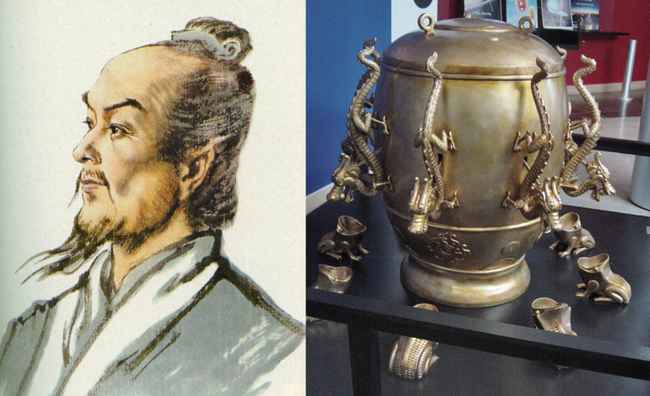
Left: a portrait of Zhang Heng. Right: a replica of Zhang Heng's seismoscope.
Zhang Heng (张衡), an astronomer in the Eastern Han Dynasty, manufactured scientific instruments such as armillary spheres (浑天仪) and seismoscope (地动仪) with superb craftsmanship. The principles of making these instruments are still used today.
Zhang Heng also wrote Ling Xian (or the Spiritual Constitution of the Universe, 《灵宪》), an astronomical masterpiece. It comprehensively expounded on many major topics in astronomy, including scientific explanations of the cause of the lunar eclipse, which was the first in the world.
Literature
As mentioned above, the Book of Han and Shuowen Jiezi were written during the Eastern Han Dynasty.
The former is the first in the annals-biography form to cover a single dynasty (Western Han) and is the best source (sometimes the only one) for many topics in this period.
The latter is the first Chinese dictionary that provides systematic character structure analysis, including for radicals, and it has become the origin of the study of Chinese characters.
Medicine

Illustrations of Zhang Zhongjing and Hua Tuo
Famous Chinese medicine experts such as Zhang Zhongjing (张仲景) and Hua Tuo (华佗) emerged during the late Eastern Han period.
Zhang Zhongjing, who was later revered as the "saint of medicine", improved the theory and clinical practice processes of Chinese medicine. His work, Shanghan Lun (or Treatise on Cold Damage Diseases, 《伤寒杂病论》) was the first Chinese medicine classic to combine theory, method, prescription, and medicine.
Meanwhile, Hua Tuo was the first recorded surgeon to use anesthesia techniques to treat patients. He also created the earliest fitness exercises in the world, Wu Qin Xi (or Five Animal Play, 五禽戏).